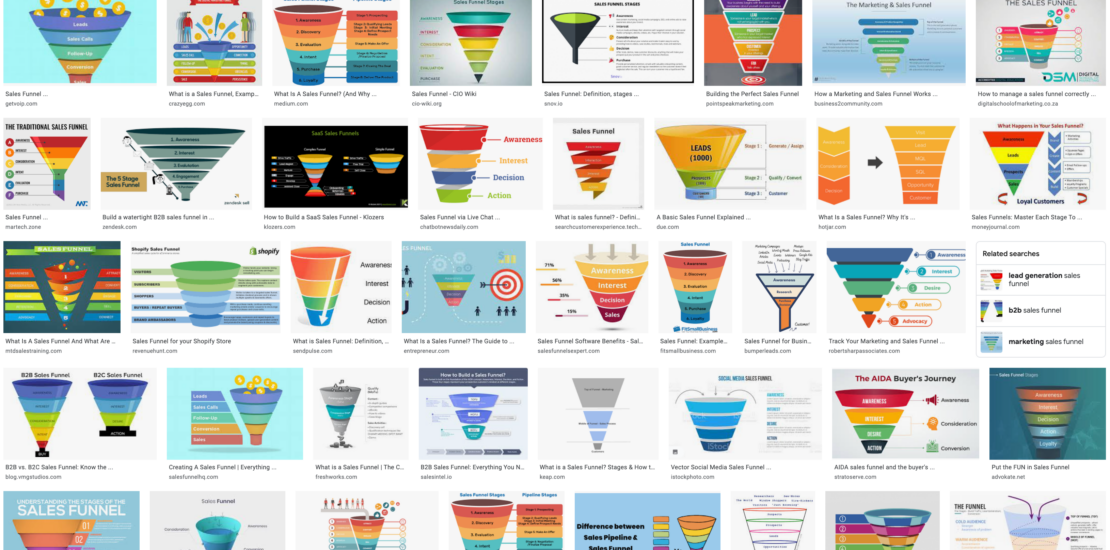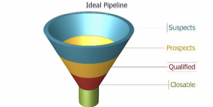- September 29, 2021
- Posted by: Dave Kurlan
- Category: Understanding the Sales Force

Have you ever conducted a Google or Amazon search for one thing only to be presented with search results that were completely different than what you were looking for?
I was looking for an image of a sales funnel and couldn’t believe what I found! My search results can be found here. Can you believe all of those images of sales funnels? Look them over and see if you can recognize the problem with all of them.
There were a number of marketing funnels included on the page but I wanted to see the images for sales funnels.
The first one I found had the title, “Sales Funnel Stages.” It had six stages and none of the stages were sufficiently defined so as to determine where a prospect is in the sales process or for forecasting whether the opportunity will close and when it will close. The six stages were:
- Awareness
- Interest
- Consideration
- Intent
- Evaluation
- Purchase
I’m sorry, but that is not a predictive sales funnel. Awareness is a marketing stage. Purchase is post-pipeline. Evaluation is just like consideration. Intent – is that intent with us or intent in general? This funnel is for an optimistic sales leader who wants things to look good but I guarantee that the win rate out of this funnel is brutal.
I found a variation of that funnel without the evaluation stage and with intent replaced by decision. In other words, they are evaluating!
The second funnel I found had the title, “Sales Funnel.” It was four stages so that seemed promising until I saw the stages:
- Awareness
- Interaction
- Interest
- Action
More awareness. Interaction – you mean like a conversation to get them interested? And once they were interested they were going to take action? Wow. I’m sure that has a high win-rate. Not.
Then there was a variation of that funnel where Interest is replaced by Decision. So we go from a conversation to a decision. It’s very transactional, isn’t it?
Then I found a “Detailed Guide to Building a Sales Funnel” and it even had descriptions of its five stages:
- Unaware
- Lead
- Prospect
- Customer
- Fan
In this funnel, they go from lead to prospect to customer so the only part of the sales funnel that has anything to do with selling is stage 3 – prospect! Guess what their win rate must be? This is an incorrectly named marketing funnel!
Then I found a three-stage six-part funnel that had:
- Awareness
- Visit
- Lead
- Consideration
- Marketing Qualified Lead (MQL)
- Sales Qualified Lead (SQL)
- Opportunity
- Decision
- Customer
- Awareness
It appears more complex than the funnel before this one but it is essentially the same thing with the same problem. The entire sales part of the sales funnel was 2.3 – opportunity.
It was only a matter of time before I found a graphically modern and pleasing version of the original sales process, AIDA:
- Awareness
- Interest
- Decision
- Action
Now it should make sense to you. Nearly every single pipeline, funnel and sales process shown on that page full of funnel images is based on this old, antiquated AIDA process that was developed by St. Elmo Lewis in 1898. That’s right. In the 19th century, five years before Henry Ford rolled out the first Model A from his plant in 1903, St. Elmo Lewis gave the world a sales process that is still being used by most companies.
So what should a modern funnel look like?
It should have just four stages. Any additional stages would be for marketing and if it’s marketing-related it doesn’t belong in the sales funnel!
The funnel should mimmic the sales process. The stages don’t necessarily need to have the same names but the stages should represent the same milestones.
The funnel or pipeline should trace the evolution of a sales opportunity as it moves from suspect to prospect to qualified opportunity to closable opportunity.

- Suspect – you have a first meeting, call, or video scheduled (3 milestones) based on discovering that they have issues that you can address
- Prospect – they have a compelling reason to buy what you sell and buy it from you (5 milestones)
- Qualified – they are thoroughly qualified to do business with you (7 milestones)
- Closable – they have given you a verbal and you are waiting to formalize the agreement (3 milestones)
If you want to see what a funnel should look like when you bring it to life, in the context of a full and comprehensive sales process, then watch this video. It has a run-time of ten minutes. I have shared this video before so if you have seen it and don’t need to see it in the context of this article, feel free to skip past.
You heard and saw in the video that the only complete sales process with a built-in methodology is Baseline Selling. Baseline Selling is pre-integrated and easy to further customize in the Baseline Selling edition of Membrain, simply the best sales-specific CRM application on the planet. Check it out here.
The danger of having your funnel rooted in 120-year-old theory becomes even more troublesome when your sales training and coaching is based on this and it is this which is integrated into your CRM.
It should be crystal clear by now that most of what you learn about sales today, is no more relevant, thorough, fresh, on-point or correct than the sales process served up by St. Elmo Lewis in 1898.
